Effective Place Value Instruction: Strategies and Curriculum Review
VerifiedAdded on 2023/06/17
|13
|3437
|65
Essay
AI Summary
This essay delves into the concept of place value in mathematics, emphasizing its importance in building students' number sense and laying the foundation for multi-digit operations. It discusses the role of diagnostic interviews in assessing students' understanding and tailoring instruction to address individual needs. The study identifies common issues students face, such as differentiating between face value and place value, and explores effective teaching strategies like using place value mats and visual aids to overcome these challenges. Furthermore, it connects these strategies to the Australian curriculum, highlighting the importance of a gradual and engaging approach to teaching place value. The essay concludes by emphasizing key tasks and activities that can consolidate students' learning and promote a deeper understanding of place value principles.
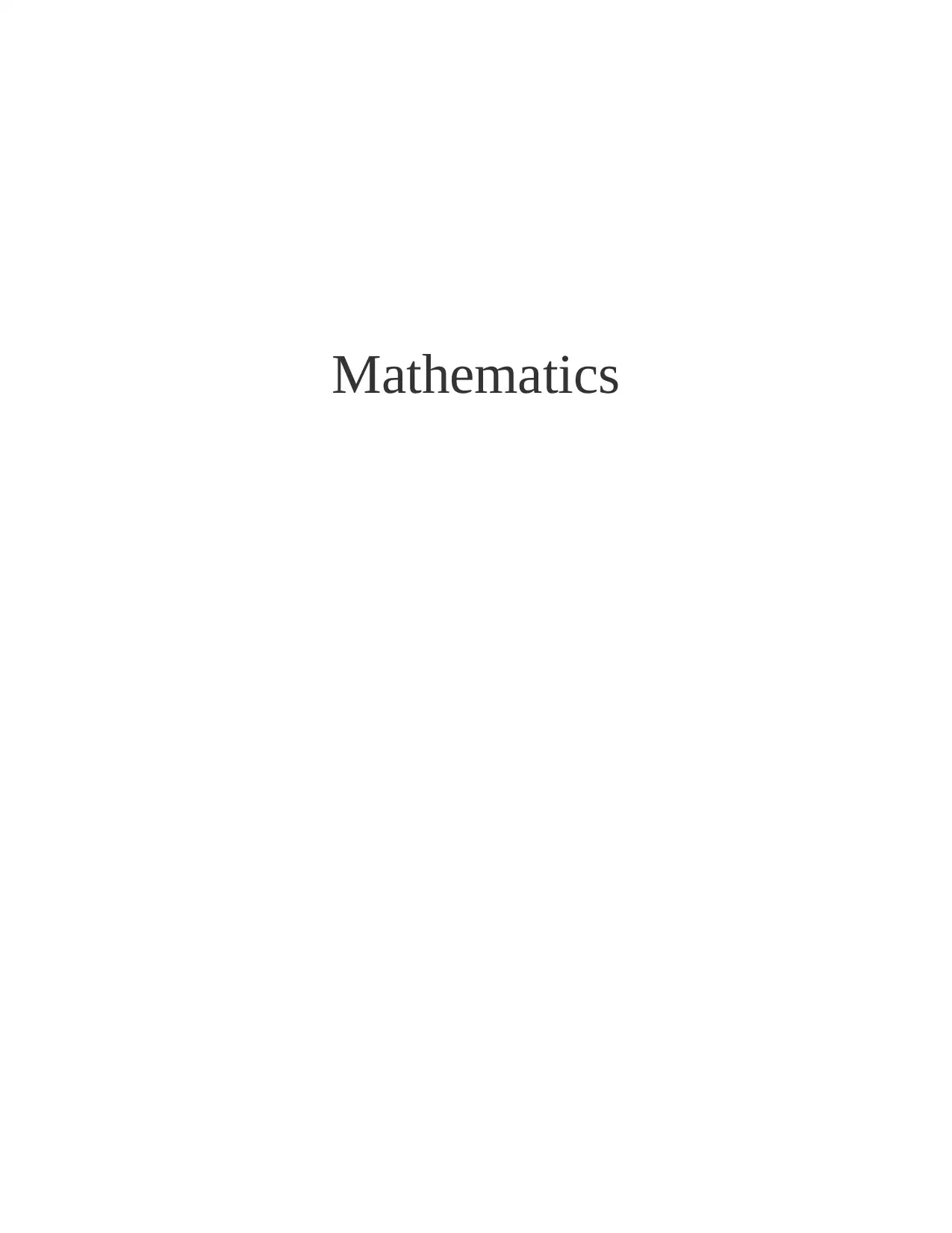
Mathematics
Paraphrase This Document
Need a fresh take? Get an instant paraphrase of this document with our AI Paraphraser
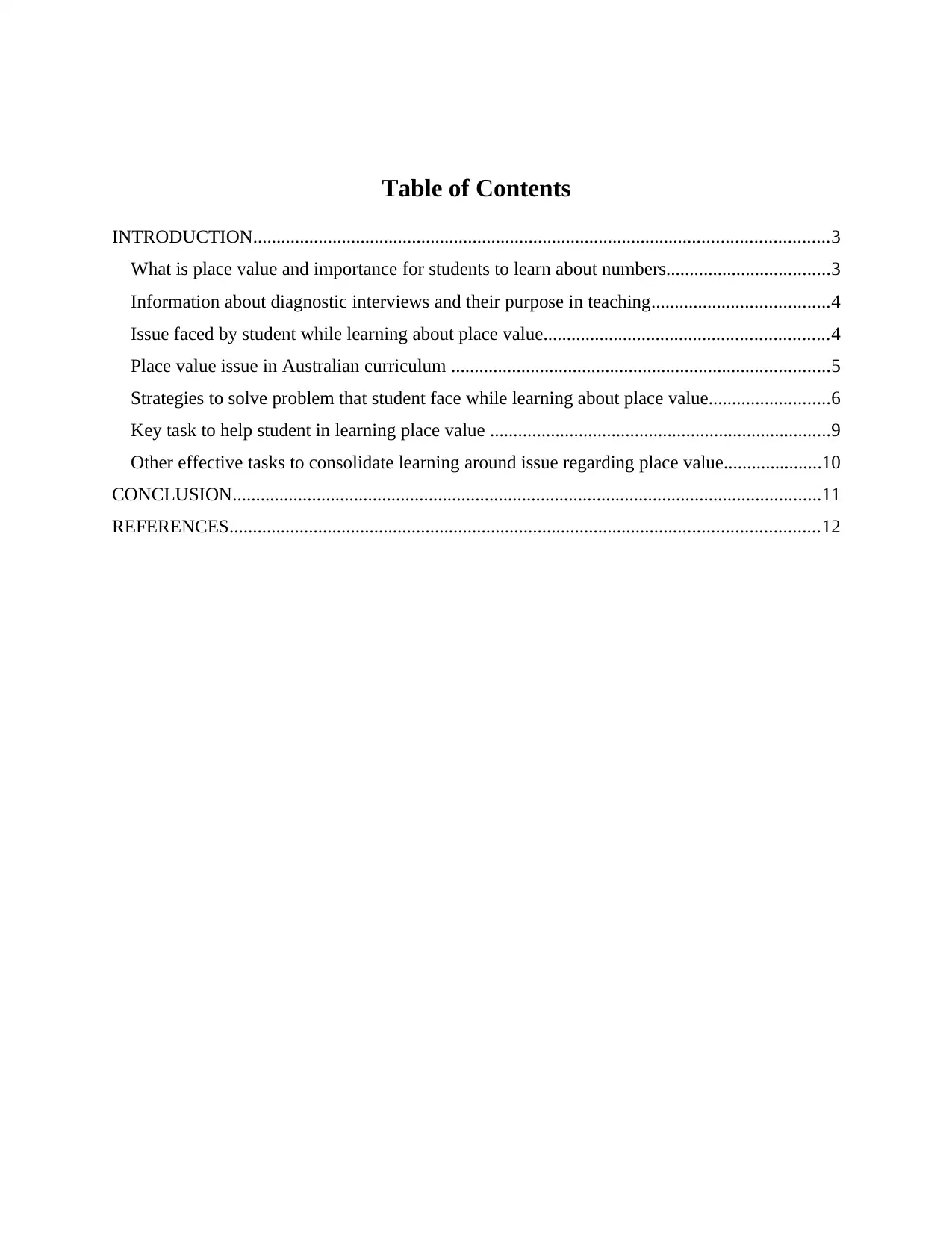
Table of Contents
INTRODUCTION...........................................................................................................................3
What is place value and importance for students to learn about numbers...................................3
Information about diagnostic interviews and their purpose in teaching......................................4
Issue faced by student while learning about place value.............................................................4
Place value issue in Australian curriculum .................................................................................5
Strategies to solve problem that student face while learning about place value..........................6
Key task to help student in learning place value .........................................................................9
Other effective tasks to consolidate learning around issue regarding place value.....................10
CONCLUSION..............................................................................................................................11
REFERENCES..............................................................................................................................12
INTRODUCTION...........................................................................................................................3
What is place value and importance for students to learn about numbers...................................3
Information about diagnostic interviews and their purpose in teaching......................................4
Issue faced by student while learning about place value.............................................................4
Place value issue in Australian curriculum .................................................................................5
Strategies to solve problem that student face while learning about place value..........................6
Key task to help student in learning place value .........................................................................9
Other effective tasks to consolidate learning around issue regarding place value.....................10
CONCLUSION..............................................................................................................................11
REFERENCES..............................................................................................................................12
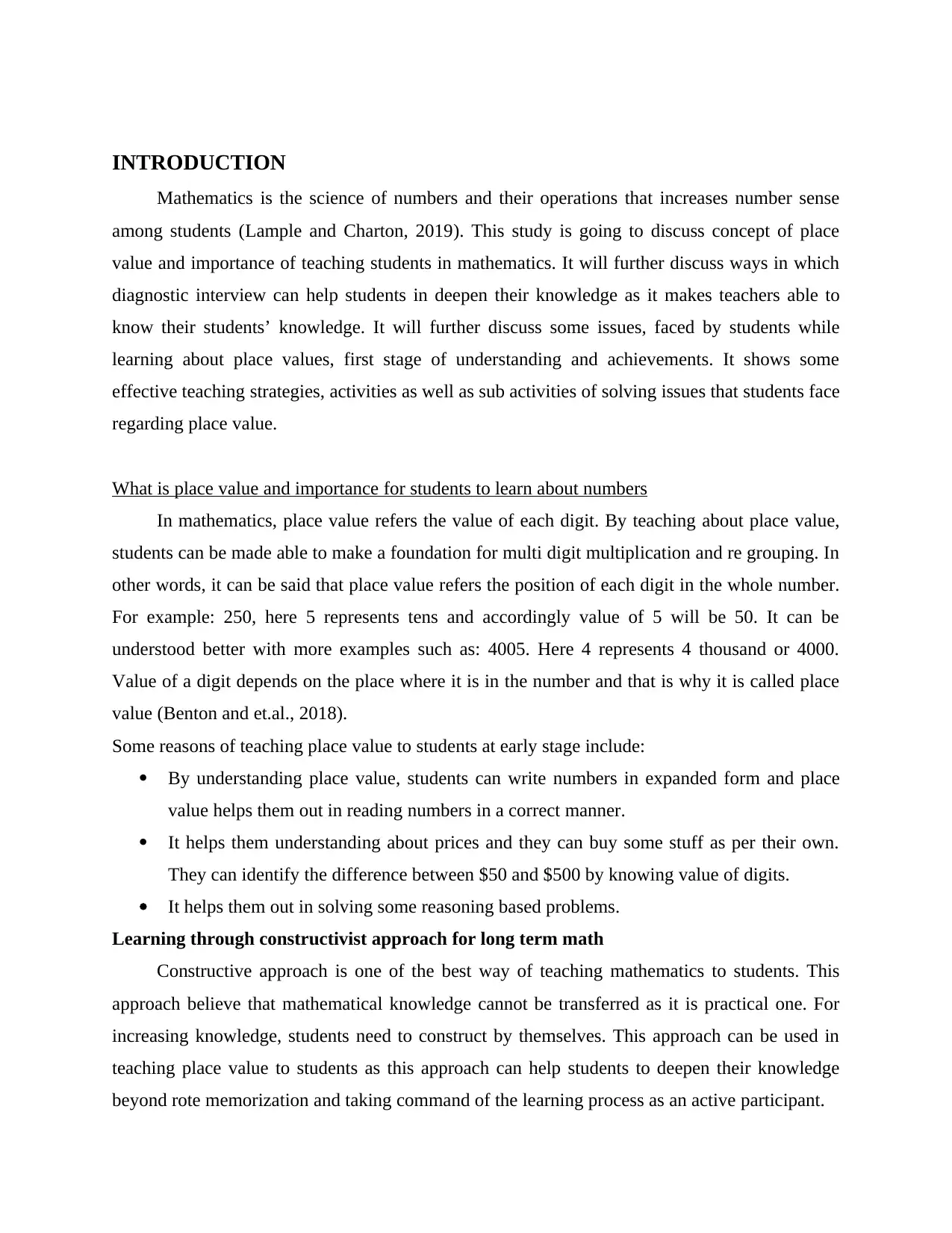
INTRODUCTION
Mathematics is the science of numbers and their operations that increases number sense
among students (Lample and Charton, 2019). This study is going to discuss concept of place
value and importance of teaching students in mathematics. It will further discuss ways in which
diagnostic interview can help students in deepen their knowledge as it makes teachers able to
know their students’ knowledge. It will further discuss some issues, faced by students while
learning about place values, first stage of understanding and achievements. It shows some
effective teaching strategies, activities as well as sub activities of solving issues that students face
regarding place value.
What is place value and importance for students to learn about numbers
In mathematics, place value refers the value of each digit. By teaching about place value,
students can be made able to make a foundation for multi digit multiplication and re grouping. In
other words, it can be said that place value refers the position of each digit in the whole number.
For example: 250, here 5 represents tens and accordingly value of 5 will be 50. It can be
understood better with more examples such as: 4005. Here 4 represents 4 thousand or 4000.
Value of a digit depends on the place where it is in the number and that is why it is called place
value (Benton and et.al., 2018).
Some reasons of teaching place value to students at early stage include:
By understanding place value, students can write numbers in expanded form and place
value helps them out in reading numbers in a correct manner.
It helps them understanding about prices and they can buy some stuff as per their own.
They can identify the difference between $50 and $500 by knowing value of digits.
It helps them out in solving some reasoning based problems.
Learning through constructivist approach for long term math
Constructive approach is one of the best way of teaching mathematics to students. This
approach believe that mathematical knowledge cannot be transferred as it is practical one. For
increasing knowledge, students need to construct by themselves. This approach can be used in
teaching place value to students as this approach can help students to deepen their knowledge
beyond rote memorization and taking command of the learning process as an active participant.
Mathematics is the science of numbers and their operations that increases number sense
among students (Lample and Charton, 2019). This study is going to discuss concept of place
value and importance of teaching students in mathematics. It will further discuss ways in which
diagnostic interview can help students in deepen their knowledge as it makes teachers able to
know their students’ knowledge. It will further discuss some issues, faced by students while
learning about place values, first stage of understanding and achievements. It shows some
effective teaching strategies, activities as well as sub activities of solving issues that students face
regarding place value.
What is place value and importance for students to learn about numbers
In mathematics, place value refers the value of each digit. By teaching about place value,
students can be made able to make a foundation for multi digit multiplication and re grouping. In
other words, it can be said that place value refers the position of each digit in the whole number.
For example: 250, here 5 represents tens and accordingly value of 5 will be 50. It can be
understood better with more examples such as: 4005. Here 4 represents 4 thousand or 4000.
Value of a digit depends on the place where it is in the number and that is why it is called place
value (Benton and et.al., 2018).
Some reasons of teaching place value to students at early stage include:
By understanding place value, students can write numbers in expanded form and place
value helps them out in reading numbers in a correct manner.
It helps them understanding about prices and they can buy some stuff as per their own.
They can identify the difference between $50 and $500 by knowing value of digits.
It helps them out in solving some reasoning based problems.
Learning through constructivist approach for long term math
Constructive approach is one of the best way of teaching mathematics to students. This
approach believe that mathematical knowledge cannot be transferred as it is practical one. For
increasing knowledge, students need to construct by themselves. This approach can be used in
teaching place value to students as this approach can help students to deepen their knowledge
beyond rote memorization and taking command of the learning process as an active participant.
⊘ This is a preview!⊘
Do you want full access?
Subscribe today to unlock all pages.

Trusted by 1+ million students worldwide
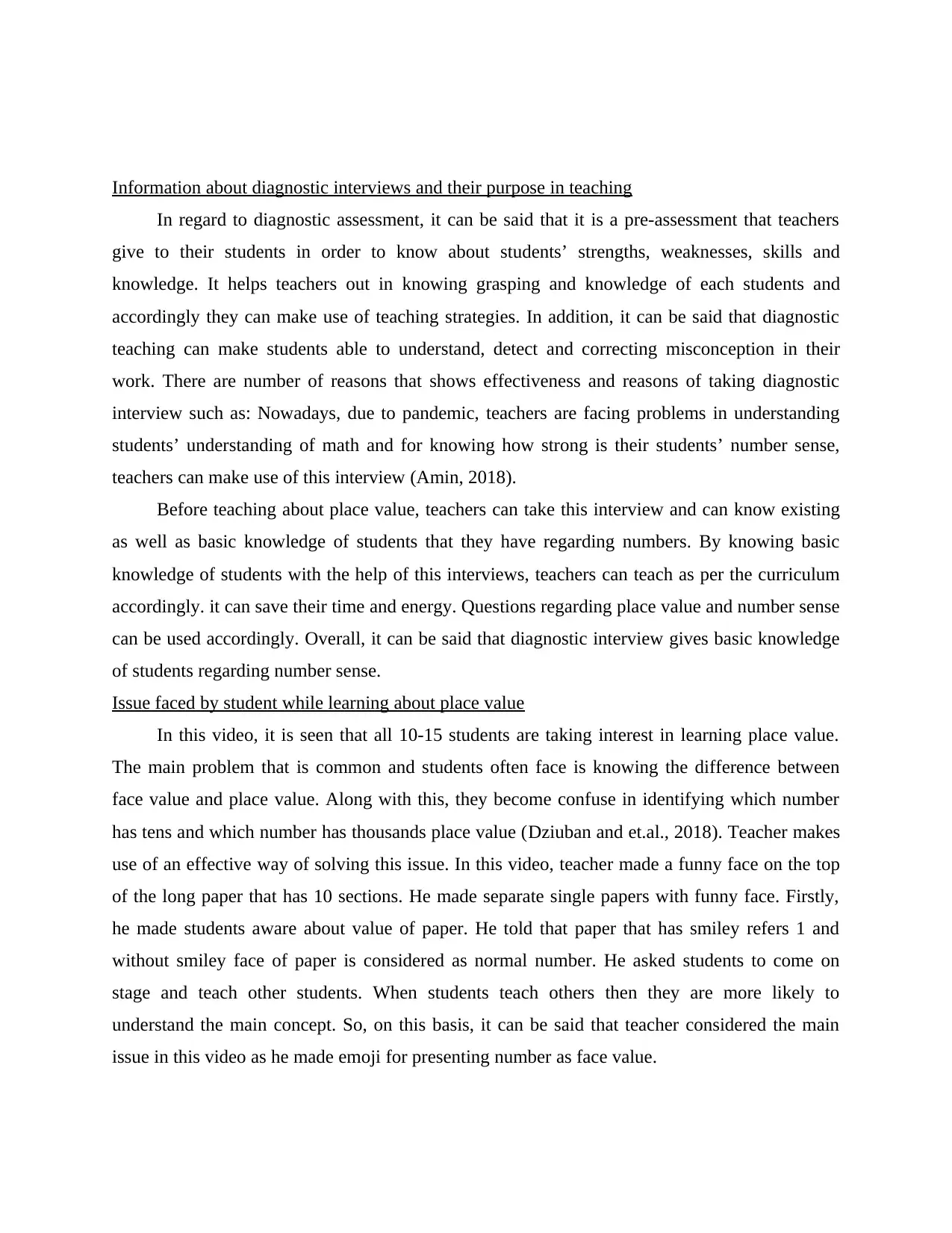
Information about diagnostic interviews and their purpose in teaching
In regard to diagnostic assessment, it can be said that it is a pre-assessment that teachers
give to their students in order to know about students’ strengths, weaknesses, skills and
knowledge. It helps teachers out in knowing grasping and knowledge of each students and
accordingly they can make use of teaching strategies. In addition, it can be said that diagnostic
teaching can make students able to understand, detect and correcting misconception in their
work. There are number of reasons that shows effectiveness and reasons of taking diagnostic
interview such as: Nowadays, due to pandemic, teachers are facing problems in understanding
students’ understanding of math and for knowing how strong is their students’ number sense,
teachers can make use of this interview (Amin, 2018).
Before teaching about place value, teachers can take this interview and can know existing
as well as basic knowledge of students that they have regarding numbers. By knowing basic
knowledge of students with the help of this interviews, teachers can teach as per the curriculum
accordingly. it can save their time and energy. Questions regarding place value and number sense
can be used accordingly. Overall, it can be said that diagnostic interview gives basic knowledge
of students regarding number sense.
Issue faced by student while learning about place value
In this video, it is seen that all 10-15 students are taking interest in learning place value.
The main problem that is common and students often face is knowing the difference between
face value and place value. Along with this, they become confuse in identifying which number
has tens and which number has thousands place value (Dziuban and et.al., 2018). Teacher makes
use of an effective way of solving this issue. In this video, teacher made a funny face on the top
of the long paper that has 10 sections. He made separate single papers with funny face. Firstly,
he made students aware about value of paper. He told that paper that has smiley refers 1 and
without smiley face of paper is considered as normal number. He asked students to come on
stage and teach other students. When students teach others then they are more likely to
understand the main concept. So, on this basis, it can be said that teacher considered the main
issue in this video as he made emoji for presenting number as face value.
In regard to diagnostic assessment, it can be said that it is a pre-assessment that teachers
give to their students in order to know about students’ strengths, weaknesses, skills and
knowledge. It helps teachers out in knowing grasping and knowledge of each students and
accordingly they can make use of teaching strategies. In addition, it can be said that diagnostic
teaching can make students able to understand, detect and correcting misconception in their
work. There are number of reasons that shows effectiveness and reasons of taking diagnostic
interview such as: Nowadays, due to pandemic, teachers are facing problems in understanding
students’ understanding of math and for knowing how strong is their students’ number sense,
teachers can make use of this interview (Amin, 2018).
Before teaching about place value, teachers can take this interview and can know existing
as well as basic knowledge of students that they have regarding numbers. By knowing basic
knowledge of students with the help of this interviews, teachers can teach as per the curriculum
accordingly. it can save their time and energy. Questions regarding place value and number sense
can be used accordingly. Overall, it can be said that diagnostic interview gives basic knowledge
of students regarding number sense.
Issue faced by student while learning about place value
In this video, it is seen that all 10-15 students are taking interest in learning place value.
The main problem that is common and students often face is knowing the difference between
face value and place value. Along with this, they become confuse in identifying which number
has tens and which number has thousands place value (Dziuban and et.al., 2018). Teacher makes
use of an effective way of solving this issue. In this video, teacher made a funny face on the top
of the long paper that has 10 sections. He made separate single papers with funny face. Firstly,
he made students aware about value of paper. He told that paper that has smiley refers 1 and
without smiley face of paper is considered as normal number. He asked students to come on
stage and teach other students. When students teach others then they are more likely to
understand the main concept. So, on this basis, it can be said that teacher considered the main
issue in this video as he made emoji for presenting number as face value.
Paraphrase This Document
Need a fresh take? Get an instant paraphrase of this document with our AI Paraphraser
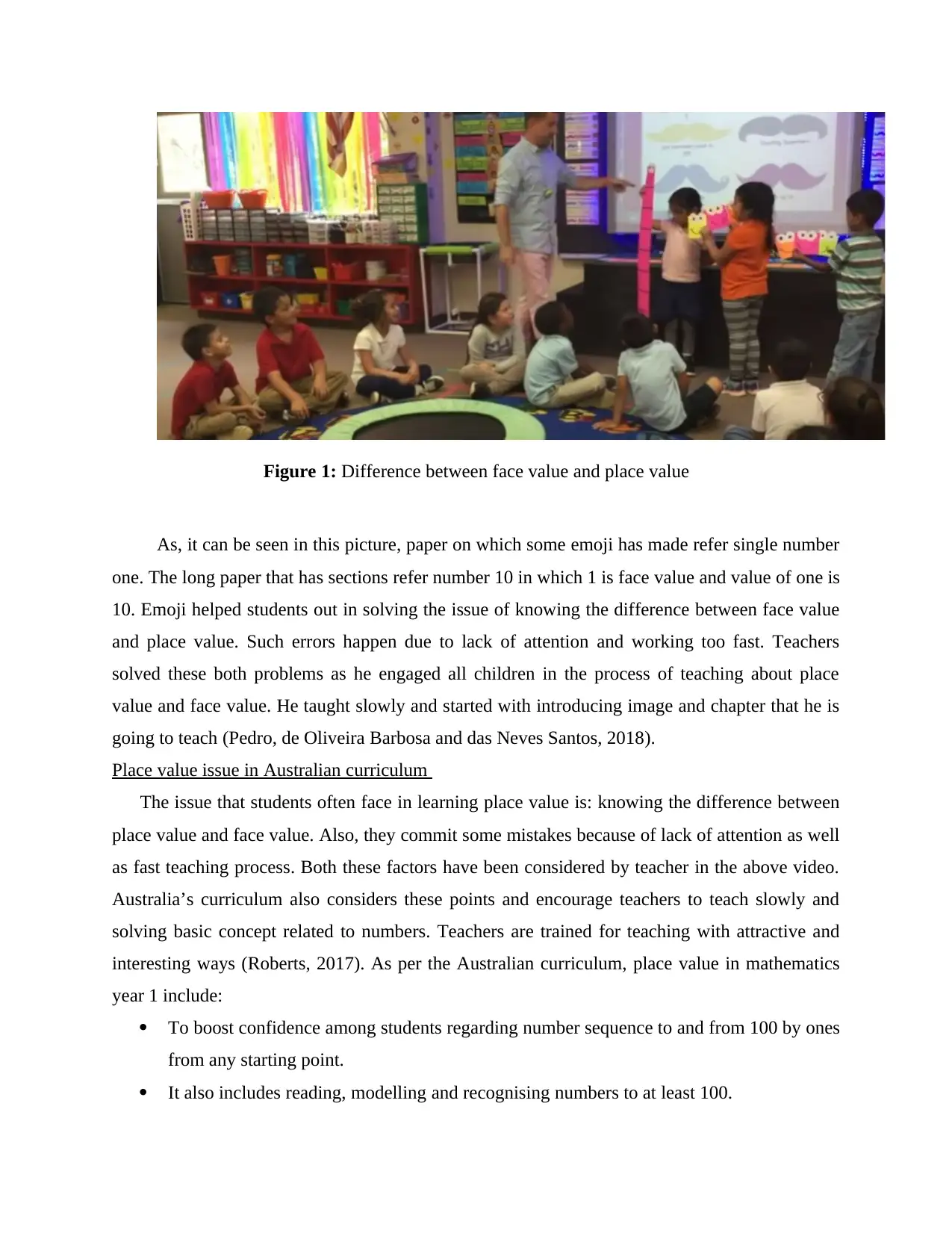
Figure 1: Difference between face value and place value
As, it can be seen in this picture, paper on which some emoji has made refer single number
one. The long paper that has sections refer number 10 in which 1 is face value and value of one is
10. Emoji helped students out in solving the issue of knowing the difference between face value
and place value. Such errors happen due to lack of attention and working too fast. Teachers
solved these both problems as he engaged all children in the process of teaching about place
value and face value. He taught slowly and started with introducing image and chapter that he is
going to teach (Pedro, de Oliveira Barbosa and das Neves Santos, 2018).
Place value issue in Australian curriculum
The issue that students often face in learning place value is: knowing the difference between
place value and face value. Also, they commit some mistakes because of lack of attention as well
as fast teaching process. Both these factors have been considered by teacher in the above video.
Australia’s curriculum also considers these points and encourage teachers to teach slowly and
solving basic concept related to numbers. Teachers are trained for teaching with attractive and
interesting ways (Roberts, 2017). As per the Australian curriculum, place value in mathematics
year 1 include:
To boost confidence among students regarding number sequence to and from 100 by ones
from any starting point.
It also includes reading, modelling and recognising numbers to at least 100.
As, it can be seen in this picture, paper on which some emoji has made refer single number
one. The long paper that has sections refer number 10 in which 1 is face value and value of one is
10. Emoji helped students out in solving the issue of knowing the difference between face value
and place value. Such errors happen due to lack of attention and working too fast. Teachers
solved these both problems as he engaged all children in the process of teaching about place
value and face value. He taught slowly and started with introducing image and chapter that he is
going to teach (Pedro, de Oliveira Barbosa and das Neves Santos, 2018).
Place value issue in Australian curriculum
The issue that students often face in learning place value is: knowing the difference between
place value and face value. Also, they commit some mistakes because of lack of attention as well
as fast teaching process. Both these factors have been considered by teacher in the above video.
Australia’s curriculum also considers these points and encourage teachers to teach slowly and
solving basic concept related to numbers. Teachers are trained for teaching with attractive and
interesting ways (Roberts, 2017). As per the Australian curriculum, place value in mathematics
year 1 include:
To boost confidence among students regarding number sequence to and from 100 by ones
from any starting point.
It also includes reading, modelling and recognising numbers to at least 100.
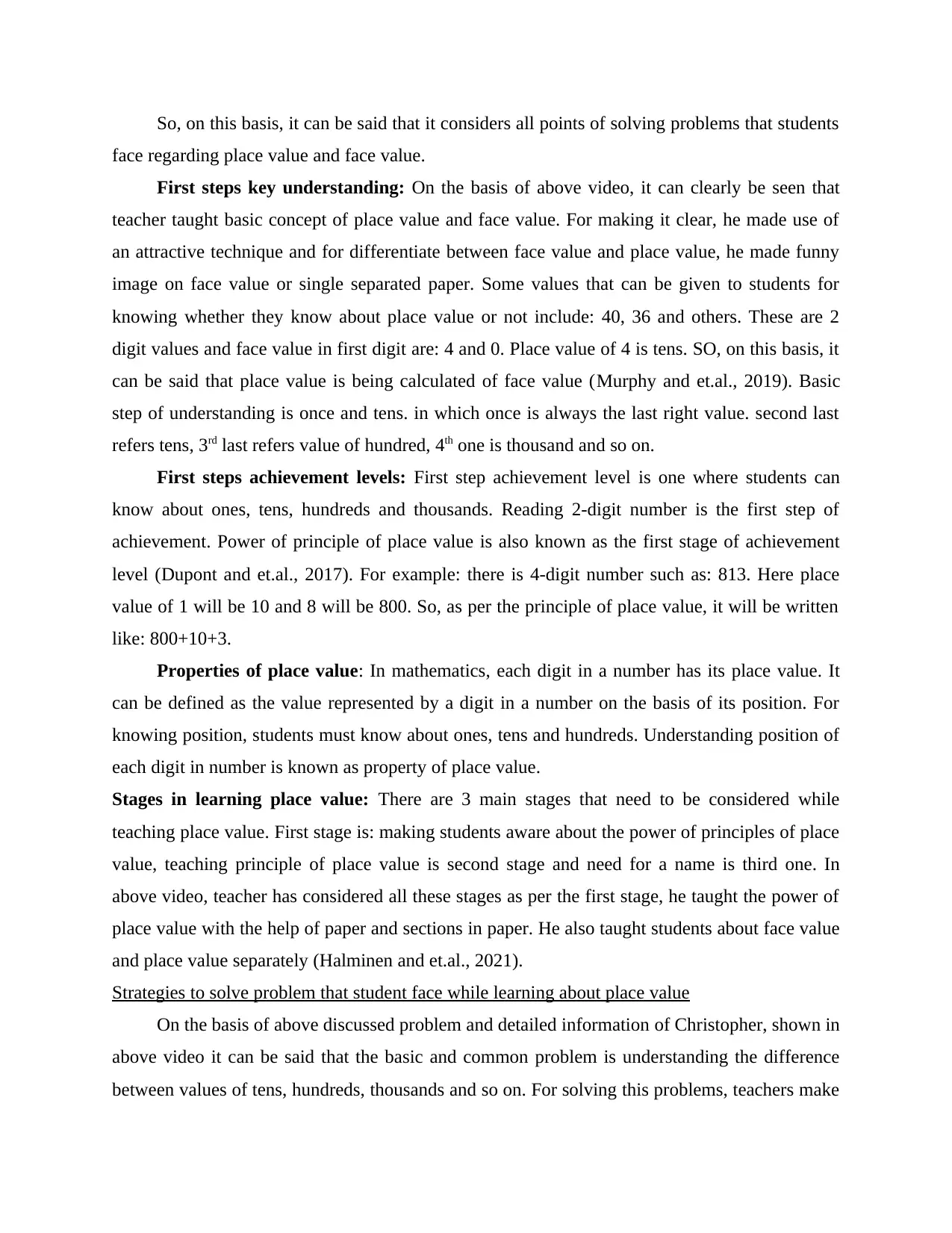
So, on this basis, it can be said that it considers all points of solving problems that students
face regarding place value and face value.
First steps key understanding: On the basis of above video, it can clearly be seen that
teacher taught basic concept of place value and face value. For making it clear, he made use of
an attractive technique and for differentiate between face value and place value, he made funny
image on face value or single separated paper. Some values that can be given to students for
knowing whether they know about place value or not include: 40, 36 and others. These are 2
digit values and face value in first digit are: 4 and 0. Place value of 4 is tens. SO, on this basis, it
can be said that place value is being calculated of face value (Murphy and et.al., 2019). Basic
step of understanding is once and tens. in which once is always the last right value. second last
refers tens, 3rd last refers value of hundred, 4th one is thousand and so on.
First steps achievement levels: First step achievement level is one where students can
know about ones, tens, hundreds and thousands. Reading 2-digit number is the first step of
achievement. Power of principle of place value is also known as the first stage of achievement
level (Dupont and et.al., 2017). For example: there is 4-digit number such as: 813. Here place
value of 1 will be 10 and 8 will be 800. So, as per the principle of place value, it will be written
like: 800+10+3.
Properties of place value: In mathematics, each digit in a number has its place value. It
can be defined as the value represented by a digit in a number on the basis of its position. For
knowing position, students must know about ones, tens and hundreds. Understanding position of
each digit in number is known as property of place value.
Stages in learning place value: There are 3 main stages that need to be considered while
teaching place value. First stage is: making students aware about the power of principles of place
value, teaching principle of place value is second stage and need for a name is third one. In
above video, teacher has considered all these stages as per the first stage, he taught the power of
place value with the help of paper and sections in paper. He also taught students about face value
and place value separately (Halminen and et.al., 2021).
Strategies to solve problem that student face while learning about place value
On the basis of above discussed problem and detailed information of Christopher, shown in
above video it can be said that the basic and common problem is understanding the difference
between values of tens, hundreds, thousands and so on. For solving this problems, teachers make
face regarding place value and face value.
First steps key understanding: On the basis of above video, it can clearly be seen that
teacher taught basic concept of place value and face value. For making it clear, he made use of
an attractive technique and for differentiate between face value and place value, he made funny
image on face value or single separated paper. Some values that can be given to students for
knowing whether they know about place value or not include: 40, 36 and others. These are 2
digit values and face value in first digit are: 4 and 0. Place value of 4 is tens. SO, on this basis, it
can be said that place value is being calculated of face value (Murphy and et.al., 2019). Basic
step of understanding is once and tens. in which once is always the last right value. second last
refers tens, 3rd last refers value of hundred, 4th one is thousand and so on.
First steps achievement levels: First step achievement level is one where students can
know about ones, tens, hundreds and thousands. Reading 2-digit number is the first step of
achievement. Power of principle of place value is also known as the first stage of achievement
level (Dupont and et.al., 2017). For example: there is 4-digit number such as: 813. Here place
value of 1 will be 10 and 8 will be 800. So, as per the principle of place value, it will be written
like: 800+10+3.
Properties of place value: In mathematics, each digit in a number has its place value. It
can be defined as the value represented by a digit in a number on the basis of its position. For
knowing position, students must know about ones, tens and hundreds. Understanding position of
each digit in number is known as property of place value.
Stages in learning place value: There are 3 main stages that need to be considered while
teaching place value. First stage is: making students aware about the power of principles of place
value, teaching principle of place value is second stage and need for a name is third one. In
above video, teacher has considered all these stages as per the first stage, he taught the power of
place value with the help of paper and sections in paper. He also taught students about face value
and place value separately (Halminen and et.al., 2021).
Strategies to solve problem that student face while learning about place value
On the basis of above discussed problem and detailed information of Christopher, shown in
above video it can be said that the basic and common problem is understanding the difference
between values of tens, hundreds, thousands and so on. For solving this problems, teachers make
⊘ This is a preview!⊘
Do you want full access?
Subscribe today to unlock all pages.

Trusted by 1+ million students worldwide
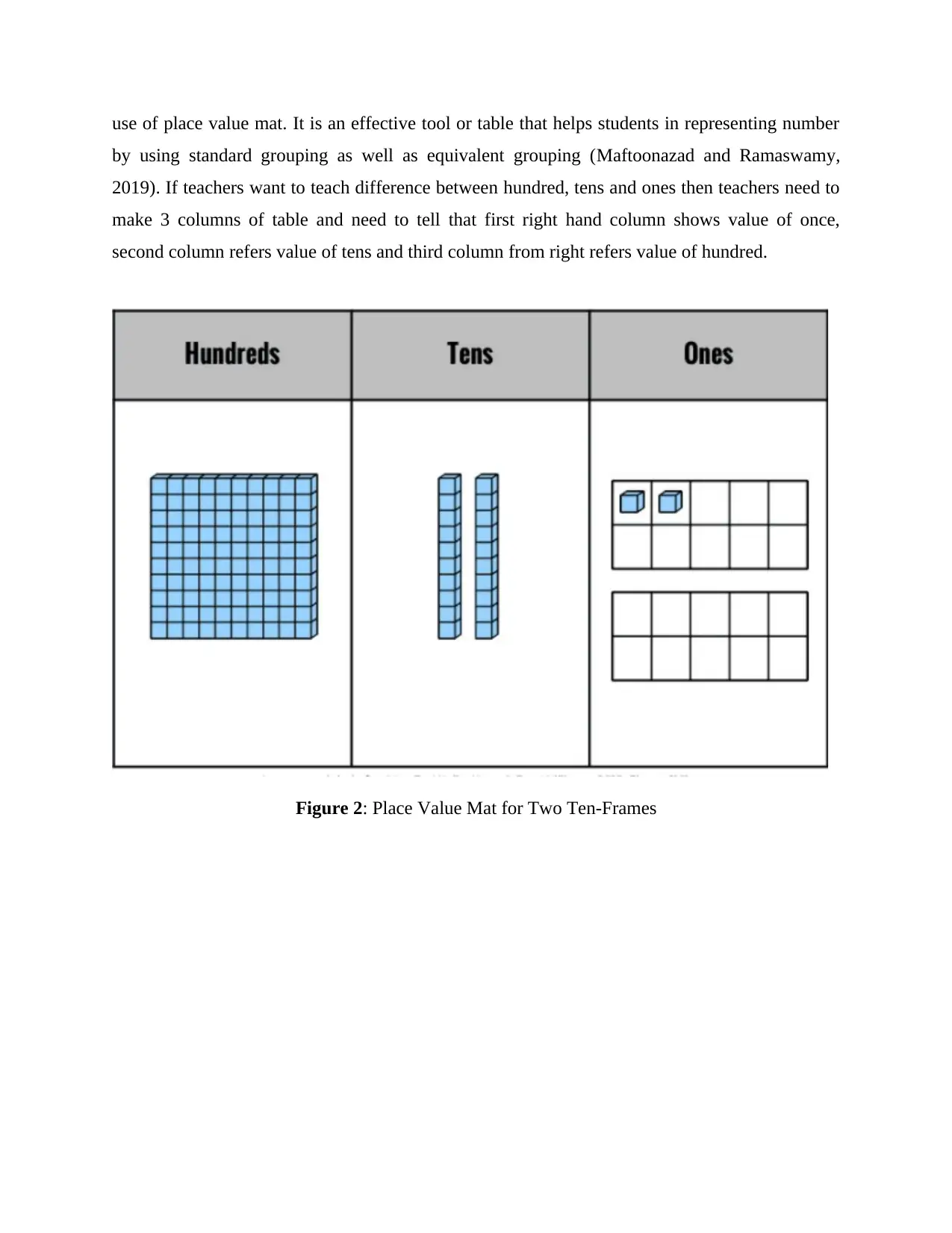
use of place value mat. It is an effective tool or table that helps students in representing number
by using standard grouping as well as equivalent grouping (Maftoonazad and Ramaswamy,
2019). If teachers want to teach difference between hundred, tens and ones then teachers need to
make 3 columns of table and need to tell that first right hand column shows value of once,
second column refers value of tens and third column from right refers value of hundred.
Figure 2: Place Value Mat for Two Ten-Frames
by using standard grouping as well as equivalent grouping (Maftoonazad and Ramaswamy,
2019). If teachers want to teach difference between hundred, tens and ones then teachers need to
make 3 columns of table and need to tell that first right hand column shows value of once,
second column refers value of tens and third column from right refers value of hundred.
Figure 2: Place Value Mat for Two Ten-Frames
Paraphrase This Document
Need a fresh take? Get an instant paraphrase of this document with our AI Paraphraser
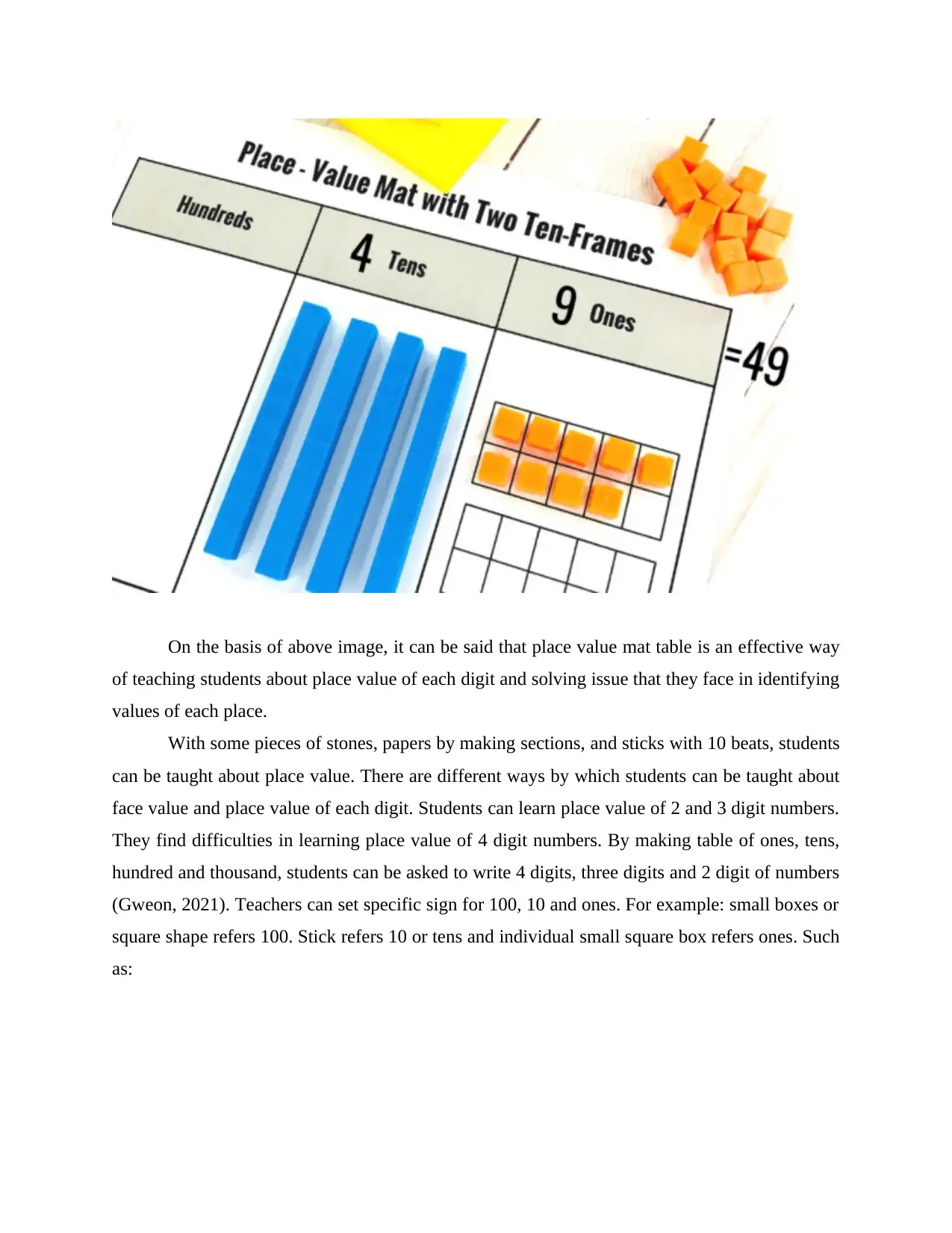
On the basis of above image, it can be said that place value mat table is an effective way
of teaching students about place value of each digit and solving issue that they face in identifying
values of each place.
With some pieces of stones, papers by making sections, and sticks with 10 beats, students
can be taught about place value. There are different ways by which students can be taught about
face value and place value of each digit. Students can learn place value of 2 and 3 digit numbers.
They find difficulties in learning place value of 4 digit numbers. By making table of ones, tens,
hundred and thousand, students can be asked to write 4 digits, three digits and 2 digit of numbers
(Gweon, 2021). Teachers can set specific sign for 100, 10 and ones. For example: small boxes or
square shape refers 100. Stick refers 10 or tens and individual small square box refers ones. Such
as:
of teaching students about place value of each digit and solving issue that they face in identifying
values of each place.
With some pieces of stones, papers by making sections, and sticks with 10 beats, students
can be taught about place value. There are different ways by which students can be taught about
face value and place value of each digit. Students can learn place value of 2 and 3 digit numbers.
They find difficulties in learning place value of 4 digit numbers. By making table of ones, tens,
hundred and thousand, students can be asked to write 4 digits, three digits and 2 digit of numbers
(Gweon, 2021). Teachers can set specific sign for 100, 10 and ones. For example: small boxes or
square shape refers 100. Stick refers 10 or tens and individual small square box refers ones. Such
as:
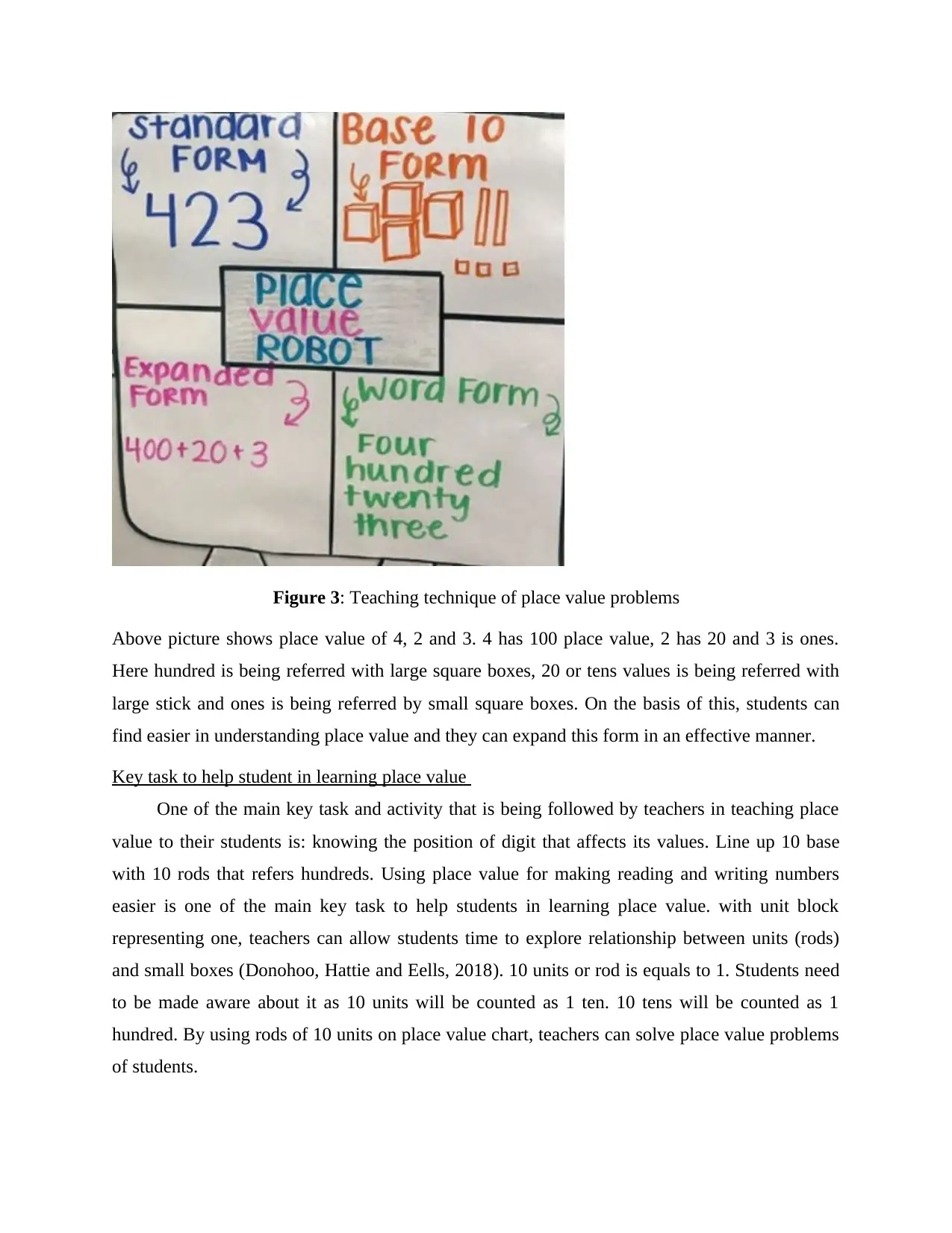
Figure 3: Teaching technique of place value problems
Above picture shows place value of 4, 2 and 3. 4 has 100 place value, 2 has 20 and 3 is ones.
Here hundred is being referred with large square boxes, 20 or tens values is being referred with
large stick and ones is being referred by small square boxes. On the basis of this, students can
find easier in understanding place value and they can expand this form in an effective manner.
Key task to help student in learning place value
One of the main key task and activity that is being followed by teachers in teaching place
value to their students is: knowing the position of digit that affects its values. Line up 10 base
with 10 rods that refers hundreds. Using place value for making reading and writing numbers
easier is one of the main key task to help students in learning place value. with unit block
representing one, teachers can allow students time to explore relationship between units (rods)
and small boxes (Donohoo, Hattie and Eells, 2018). 10 units or rod is equals to 1. Students need
to be made aware about it as 10 units will be counted as 1 ten. 10 tens will be counted as 1
hundred. By using rods of 10 units on place value chart, teachers can solve place value problems
of students.
Above picture shows place value of 4, 2 and 3. 4 has 100 place value, 2 has 20 and 3 is ones.
Here hundred is being referred with large square boxes, 20 or tens values is being referred with
large stick and ones is being referred by small square boxes. On the basis of this, students can
find easier in understanding place value and they can expand this form in an effective manner.
Key task to help student in learning place value
One of the main key task and activity that is being followed by teachers in teaching place
value to their students is: knowing the position of digit that affects its values. Line up 10 base
with 10 rods that refers hundreds. Using place value for making reading and writing numbers
easier is one of the main key task to help students in learning place value. with unit block
representing one, teachers can allow students time to explore relationship between units (rods)
and small boxes (Donohoo, Hattie and Eells, 2018). 10 units or rod is equals to 1. Students need
to be made aware about it as 10 units will be counted as 1 ten. 10 tens will be counted as 1
hundred. By using rods of 10 units on place value chart, teachers can solve place value problems
of students.
⊘ This is a preview!⊘
Do you want full access?
Subscribe today to unlock all pages.

Trusted by 1+ million students worldwide
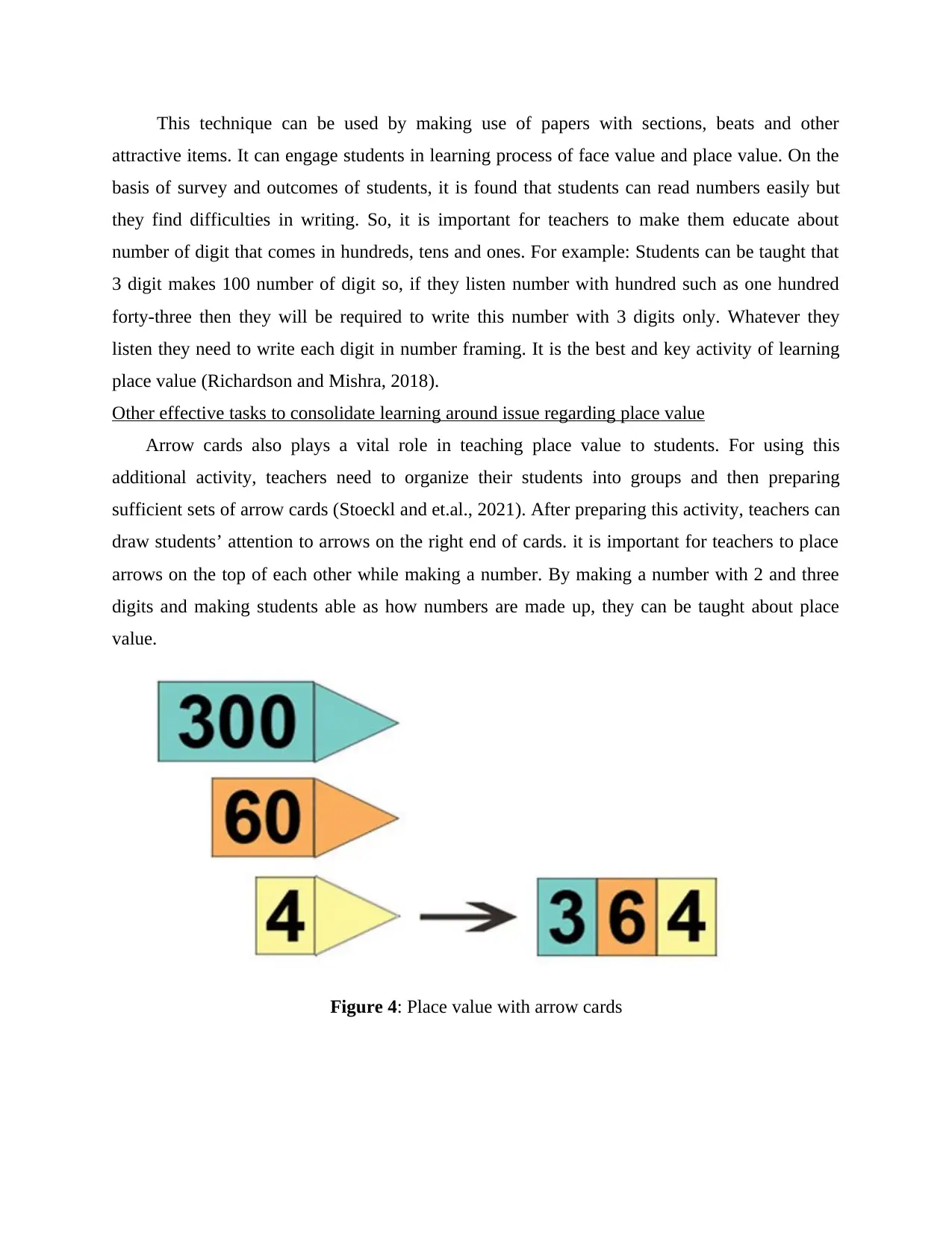
This technique can be used by making use of papers with sections, beats and other
attractive items. It can engage students in learning process of face value and place value. On the
basis of survey and outcomes of students, it is found that students can read numbers easily but
they find difficulties in writing. So, it is important for teachers to make them educate about
number of digit that comes in hundreds, tens and ones. For example: Students can be taught that
3 digit makes 100 number of digit so, if they listen number with hundred such as one hundred
forty-three then they will be required to write this number with 3 digits only. Whatever they
listen they need to write each digit in number framing. It is the best and key activity of learning
place value (Richardson and Mishra, 2018).
Other effective tasks to consolidate learning around issue regarding place value
Arrow cards also plays a vital role in teaching place value to students. For using this
additional activity, teachers need to organize their students into groups and then preparing
sufficient sets of arrow cards (Stoeckl and et.al., 2021). After preparing this activity, teachers can
draw students’ attention to arrows on the right end of cards. it is important for teachers to place
arrows on the top of each other while making a number. By making a number with 2 and three
digits and making students able as how numbers are made up, they can be taught about place
value.
Figure 4: Place value with arrow cards
attractive items. It can engage students in learning process of face value and place value. On the
basis of survey and outcomes of students, it is found that students can read numbers easily but
they find difficulties in writing. So, it is important for teachers to make them educate about
number of digit that comes in hundreds, tens and ones. For example: Students can be taught that
3 digit makes 100 number of digit so, if they listen number with hundred such as one hundred
forty-three then they will be required to write this number with 3 digits only. Whatever they
listen they need to write each digit in number framing. It is the best and key activity of learning
place value (Richardson and Mishra, 2018).
Other effective tasks to consolidate learning around issue regarding place value
Arrow cards also plays a vital role in teaching place value to students. For using this
additional activity, teachers need to organize their students into groups and then preparing
sufficient sets of arrow cards (Stoeckl and et.al., 2021). After preparing this activity, teachers can
draw students’ attention to arrows on the right end of cards. it is important for teachers to place
arrows on the top of each other while making a number. By making a number with 2 and three
digits and making students able as how numbers are made up, they can be taught about place
value.
Figure 4: Place value with arrow cards
Paraphrase This Document
Need a fresh take? Get an instant paraphrase of this document with our AI Paraphraser
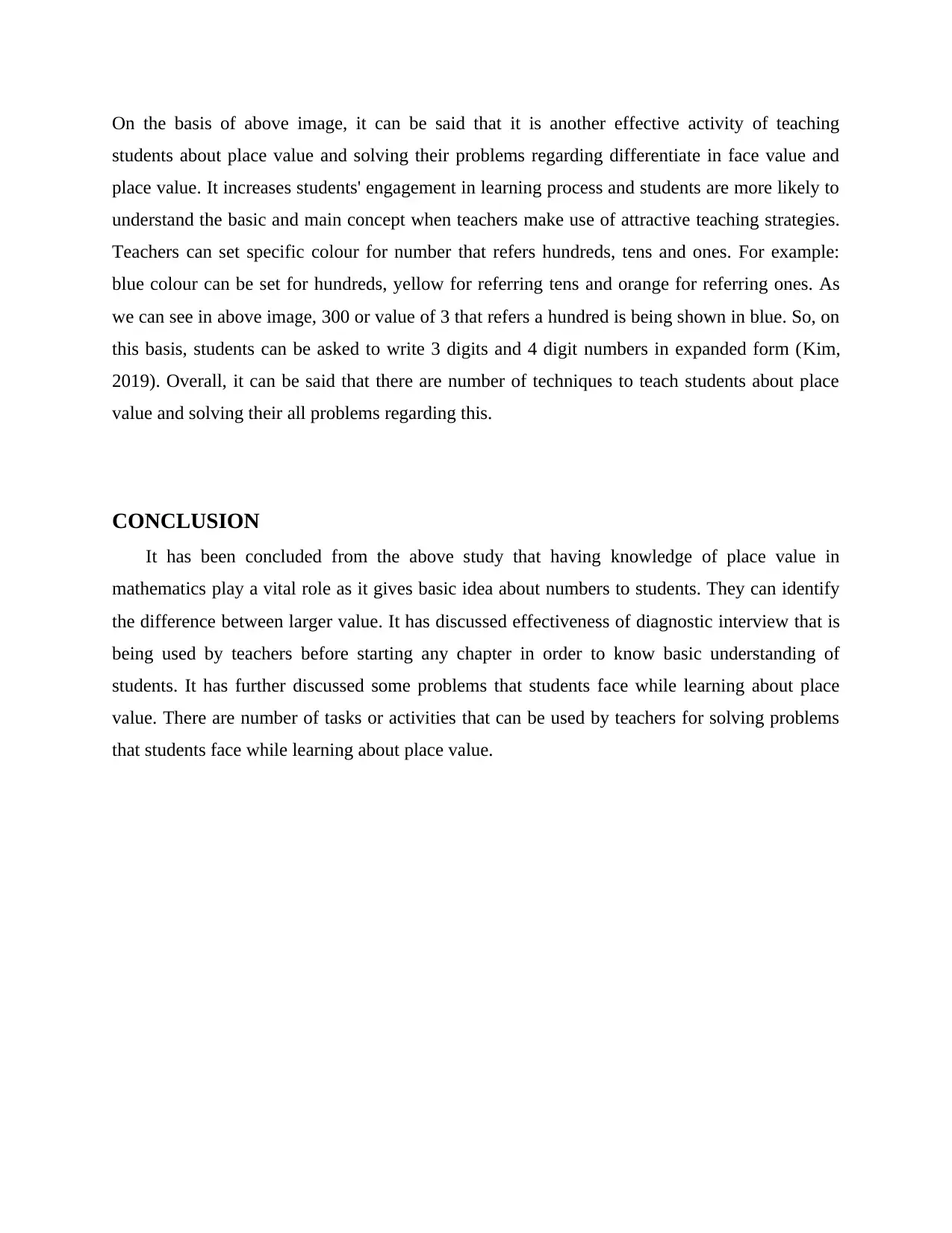
On the basis of above image, it can be said that it is another effective activity of teaching
students about place value and solving their problems regarding differentiate in face value and
place value. It increases students' engagement in learning process and students are more likely to
understand the basic and main concept when teachers make use of attractive teaching strategies.
Teachers can set specific colour for number that refers hundreds, tens and ones. For example:
blue colour can be set for hundreds, yellow for referring tens and orange for referring ones. As
we can see in above image, 300 or value of 3 that refers a hundred is being shown in blue. So, on
this basis, students can be asked to write 3 digits and 4 digit numbers in expanded form (Kim,
2019). Overall, it can be said that there are number of techniques to teach students about place
value and solving their all problems regarding this.
CONCLUSION
It has been concluded from the above study that having knowledge of place value in
mathematics play a vital role as it gives basic idea about numbers to students. They can identify
the difference between larger value. It has discussed effectiveness of diagnostic interview that is
being used by teachers before starting any chapter in order to know basic understanding of
students. It has further discussed some problems that students face while learning about place
value. There are number of tasks or activities that can be used by teachers for solving problems
that students face while learning about place value.
students about place value and solving their problems regarding differentiate in face value and
place value. It increases students' engagement in learning process and students are more likely to
understand the basic and main concept when teachers make use of attractive teaching strategies.
Teachers can set specific colour for number that refers hundreds, tens and ones. For example:
blue colour can be set for hundreds, yellow for referring tens and orange for referring ones. As
we can see in above image, 300 or value of 3 that refers a hundred is being shown in blue. So, on
this basis, students can be asked to write 3 digits and 4 digit numbers in expanded form (Kim,
2019). Overall, it can be said that there are number of techniques to teach students about place
value and solving their all problems regarding this.
CONCLUSION
It has been concluded from the above study that having knowledge of place value in
mathematics play a vital role as it gives basic idea about numbers to students. They can identify
the difference between larger value. It has discussed effectiveness of diagnostic interview that is
being used by teachers before starting any chapter in order to know basic understanding of
students. It has further discussed some problems that students face while learning about place
value. There are number of tasks or activities that can be used by teachers for solving problems
that students face while learning about place value.
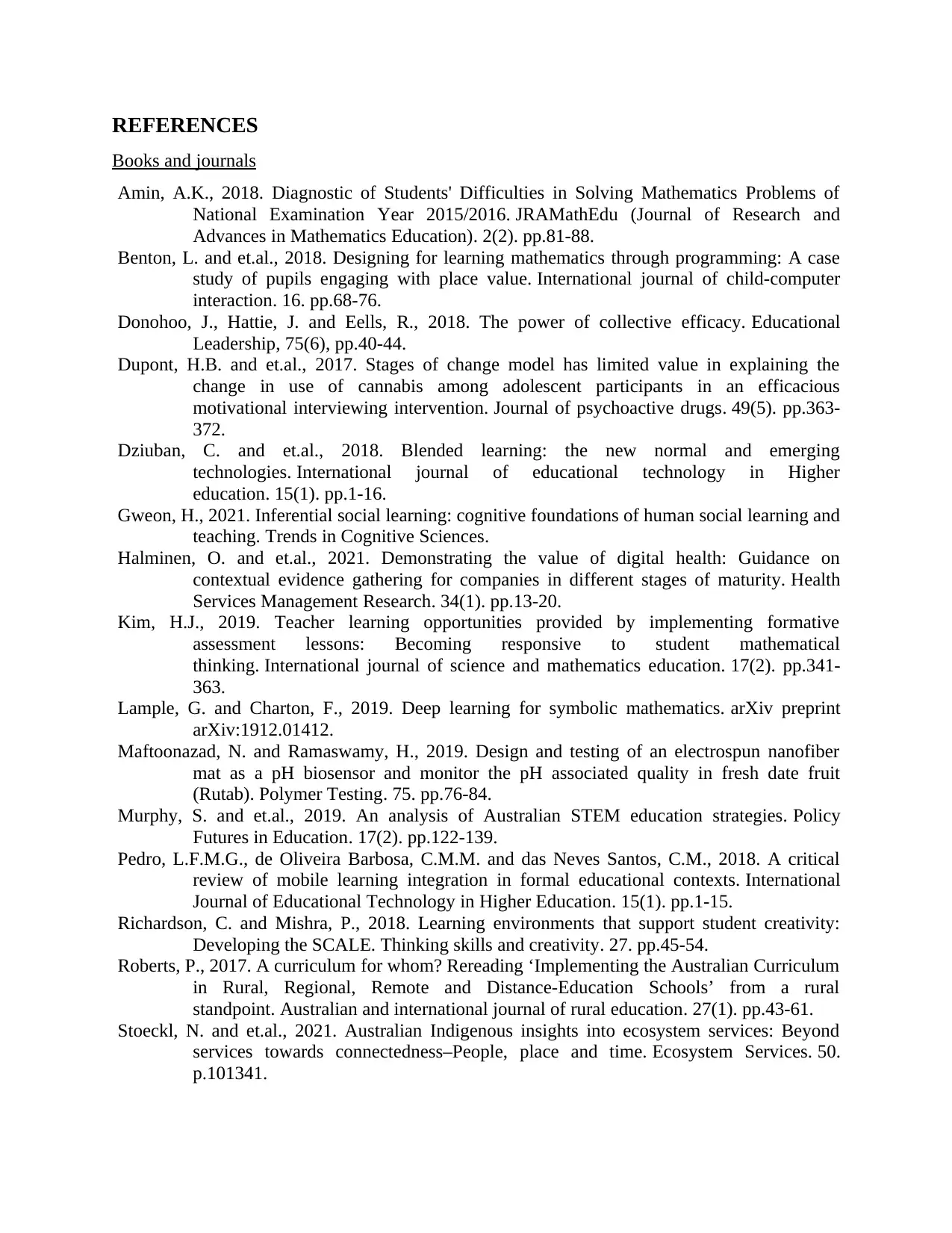
REFERENCES
Books and journals
Amin, A.K., 2018. Diagnostic of Students' Difficulties in Solving Mathematics Problems of
National Examination Year 2015/2016. JRAMathEdu (Journal of Research and
Advances in Mathematics Education). 2(2). pp.81-88.
Benton, L. and et.al., 2018. Designing for learning mathematics through programming: A case
study of pupils engaging with place value. International journal of child-computer
interaction. 16. pp.68-76.
Donohoo, J., Hattie, J. and Eells, R., 2018. The power of collective efficacy. Educational
Leadership, 75(6), pp.40-44.
Dupont, H.B. and et.al., 2017. Stages of change model has limited value in explaining the
change in use of cannabis among adolescent participants in an efficacious
motivational interviewing intervention. Journal of psychoactive drugs. 49(5). pp.363-
372.
Dziuban, C. and et.al., 2018. Blended learning: the new normal and emerging
technologies. International journal of educational technology in Higher
education. 15(1). pp.1-16.
Gweon, H., 2021. Inferential social learning: cognitive foundations of human social learning and
teaching. Trends in Cognitive Sciences.
Halminen, O. and et.al., 2021. Demonstrating the value of digital health: Guidance on
contextual evidence gathering for companies in different stages of maturity. Health
Services Management Research. 34(1). pp.13-20.
Kim, H.J., 2019. Teacher learning opportunities provided by implementing formative
assessment lessons: Becoming responsive to student mathematical
thinking. International journal of science and mathematics education. 17(2). pp.341-
363.
Lample, G. and Charton, F., 2019. Deep learning for symbolic mathematics. arXiv preprint
arXiv:1912.01412.
Maftoonazad, N. and Ramaswamy, H., 2019. Design and testing of an electrospun nanofiber
mat as a pH biosensor and monitor the pH associated quality in fresh date fruit
(Rutab). Polymer Testing. 75. pp.76-84.
Murphy, S. and et.al., 2019. An analysis of Australian STEM education strategies. Policy
Futures in Education. 17(2). pp.122-139.
Pedro, L.F.M.G., de Oliveira Barbosa, C.M.M. and das Neves Santos, C.M., 2018. A critical
review of mobile learning integration in formal educational contexts. International
Journal of Educational Technology in Higher Education. 15(1). pp.1-15.
Richardson, C. and Mishra, P., 2018. Learning environments that support student creativity:
Developing the SCALE. Thinking skills and creativity. 27. pp.45-54.
Roberts, P., 2017. A curriculum for whom? Rereading ‘Implementing the Australian Curriculum
in Rural, Regional, Remote and Distance-Education Schools’ from a rural
standpoint. Australian and international journal of rural education. 27(1). pp.43-61.
Stoeckl, N. and et.al., 2021. Australian Indigenous insights into ecosystem services: Beyond
services towards connectedness–People, place and time. Ecosystem Services. 50.
p.101341.
Books and journals
Amin, A.K., 2018. Diagnostic of Students' Difficulties in Solving Mathematics Problems of
National Examination Year 2015/2016. JRAMathEdu (Journal of Research and
Advances in Mathematics Education). 2(2). pp.81-88.
Benton, L. and et.al., 2018. Designing for learning mathematics through programming: A case
study of pupils engaging with place value. International journal of child-computer
interaction. 16. pp.68-76.
Donohoo, J., Hattie, J. and Eells, R., 2018. The power of collective efficacy. Educational
Leadership, 75(6), pp.40-44.
Dupont, H.B. and et.al., 2017. Stages of change model has limited value in explaining the
change in use of cannabis among adolescent participants in an efficacious
motivational interviewing intervention. Journal of psychoactive drugs. 49(5). pp.363-
372.
Dziuban, C. and et.al., 2018. Blended learning: the new normal and emerging
technologies. International journal of educational technology in Higher
education. 15(1). pp.1-16.
Gweon, H., 2021. Inferential social learning: cognitive foundations of human social learning and
teaching. Trends in Cognitive Sciences.
Halminen, O. and et.al., 2021. Demonstrating the value of digital health: Guidance on
contextual evidence gathering for companies in different stages of maturity. Health
Services Management Research. 34(1). pp.13-20.
Kim, H.J., 2019. Teacher learning opportunities provided by implementing formative
assessment lessons: Becoming responsive to student mathematical
thinking. International journal of science and mathematics education. 17(2). pp.341-
363.
Lample, G. and Charton, F., 2019. Deep learning for symbolic mathematics. arXiv preprint
arXiv:1912.01412.
Maftoonazad, N. and Ramaswamy, H., 2019. Design and testing of an electrospun nanofiber
mat as a pH biosensor and monitor the pH associated quality in fresh date fruit
(Rutab). Polymer Testing. 75. pp.76-84.
Murphy, S. and et.al., 2019. An analysis of Australian STEM education strategies. Policy
Futures in Education. 17(2). pp.122-139.
Pedro, L.F.M.G., de Oliveira Barbosa, C.M.M. and das Neves Santos, C.M., 2018. A critical
review of mobile learning integration in formal educational contexts. International
Journal of Educational Technology in Higher Education. 15(1). pp.1-15.
Richardson, C. and Mishra, P., 2018. Learning environments that support student creativity:
Developing the SCALE. Thinking skills and creativity. 27. pp.45-54.
Roberts, P., 2017. A curriculum for whom? Rereading ‘Implementing the Australian Curriculum
in Rural, Regional, Remote and Distance-Education Schools’ from a rural
standpoint. Australian and international journal of rural education. 27(1). pp.43-61.
Stoeckl, N. and et.al., 2021. Australian Indigenous insights into ecosystem services: Beyond
services towards connectedness–People, place and time. Ecosystem Services. 50.
p.101341.
⊘ This is a preview!⊘
Do you want full access?
Subscribe today to unlock all pages.

Trusted by 1+ million students worldwide
1 out of 13
Related Documents
Your All-in-One AI-Powered Toolkit for Academic Success.
+13062052269
info@desklib.com
Available 24*7 on WhatsApp / Email
![[object Object]](/_next/static/media/star-bottom.7253800d.svg)
Unlock your academic potential
Copyright © 2020–2025 A2Z Services. All Rights Reserved. Developed and managed by ZUCOL.





